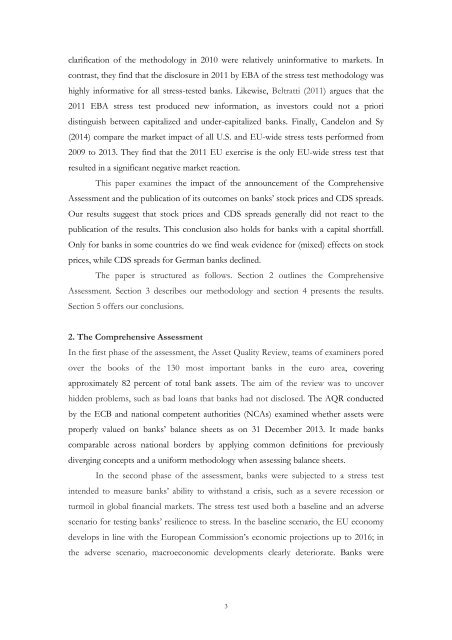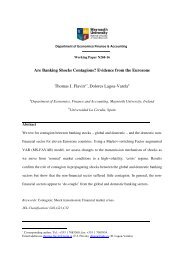n?u=RePEc:dnb:dnbwpp:463&r=ban
n?u=RePEc:dnb:dnbwpp:463&r=ban
n?u=RePEc:dnb:dnbwpp:463&r=ban
Create successful ePaper yourself
Turn your PDF publications into a flip-book with our unique Google optimized e-Paper software.
clarification of the methodology in 2010 were relatively uninformative to markets. In<br />
contrast, they find that the disclosure in 2011 by EBA of the stress test methodology was<br />
highly informative for all stress-tested banks. Likewise, Beltratti (2011) argues that the<br />
2011 EBA stress test produced new information, as investors could not a priori<br />
distinguish between capitalized and under-capitalized banks. Finally, Candelon and Sy<br />
(2014) compare the market impact of all U.S. and EU-wide stress tests performed from<br />
2009 to 2013. They find that the 2011 EU exercise is the only EU-wide stress test that<br />
resulted in a significant negative market reaction.<br />
This paper examines the impact of the announcement of the Comprehensive<br />
Assessment and the publication of its outcomes on banks’ stock prices and CDS spreads.<br />
Our results suggest that stock prices and CDS spreads generally did not react to the<br />
publication of the results. This conclusion also holds for banks with a capital shortfall.<br />
Only for banks in some countries do we find weak evidence for (mixed) effects on stock<br />
prices, while CDS spreads for German banks declined.<br />
The paper is structured as follows. Section 2 outlines the Comprehensive<br />
Assessment. Section 3 describes our methodology and section 4 presents the results.<br />
Section 5 offers our conclusions.<br />
2. The Comprehensive Assessment<br />
In the first phase of the assessment, the Asset Quality Review, teams of examiners pored<br />
over the books of the 130 most important banks in the euro area, covering<br />
approximately 82 percent of total bank assets. The aim of the review was to uncover<br />
hidden problems, such as bad loans that banks had not disclosed. The AQR conducted<br />
by the ECB and national competent authorities (NCAs) examined whether assets were<br />
properly valued on banks’ balance sheets as on 31 December 2013. It made banks<br />
comparable across national borders by applying common definitions for previously<br />
diverging concepts and a uniform methodology when assessing balance sheets.<br />
In the second phase of the assessment, banks were subjected to a stress test<br />
intended to measure banks’ ability to withstand a crisis, such as a severe recession or<br />
turmoil in global financial markets. The stress test used both a baseline and an adverse<br />
scenario for testing banks’ resilience to stress. In the baseline scenario, the EU economy<br />
develops in line with the European Commission’s economic projections up to 2016; in<br />
the adverse scenario, macroeconomic developments clearly deteriorate. Banks were<br />
<br />
3




